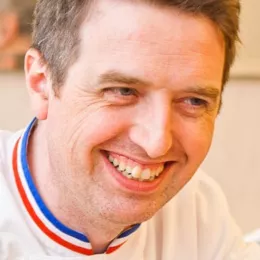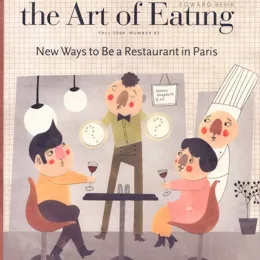In 2013, ICE launched its first-ever artisanal bread course: Artisan Bread Baking. This intensive course is designed and taught by ICE Chef-Instructor Sim Cass.
Known as the “Prince of Darkness” for his deeply toasted, crusty loaves, Sim began his career as a Pastry Chef in London and went on to become the Founding and Head Baker of Balthazar Bakery, one of the most highly-regarded restaurant and wholesale bread producers in America.
Check out this interview with Chef Sim from the launch of the course in 2013. In it, Chef Sim discusses how the course was formed as well as his own background and journey as a baker.
What was the inspiration behind this new course?
I developed a course for the regular pastry and culinary curriculum, which is only one week of bread, but I really felt that the school needs a large, more extensive course, that covers more practices and many more different types of breads and methods, which isn’t possible to do in one week.
So we’re doing 40 classes, going in depth into natural ferments, breads made the ancient way and breads made throughout history, up to now.
Will the course address the full scope of the modern bread industry—meaning both small and larger, commercial bakeries?
The course will cover A-Z in terms of how to adapt to any scale. Balthazar, even at a large scale is, ten times a day, using natural ferment and that is what I’m preaching—natural fermentation. But not only natural fermentation, because there are some breads that work very well in a combination of the old and the new.
Are there any current trends or innovators in the bread world that you find particularly interesting?
Natural ferments are the trend of the moment and the one that’s making the money. I have my own versions of trends; I’m really big on foccacias and into the pizza world. I think Paula Oland is the best baker out there – she and I did Balthazar together and she’s my mentor, she’s my favorite. She was involved in so much in the baking world, and she was inspirational to work with.
It's interesting because, from when I started working in the industry, everyone has gone backwards. All the most successful bakeries in America are using these old fermentation techniques that we used to envy in the French and the Germans. But what has happened is in Europe it’s slowed down, because all the small bakeries are going the “way of the dodo”, because the supermarchés and hypermarkets make bread in-house.
They profess to be using natural ways of making bread, and the product looks pretty good, but the taste and the crumb and the crust is always slightly under par because of the mass production and the use of commercial yeast.
How did you get into bread baking, and how did you decide to make it your career?
At 16, as soon as I could leave school, I was already working in a butcher’s shop. It was in London, and the butcher just offered me a job. I liked the cool outfit, long white coat, big bicycle. I wanted to cook because of butchery. I had gotten into the zen of butchery—the cutting of meat, the making of sausages. That is cooking, but it’s “pre-cooking”, so it was a logical step for me to go and learn how to cook.
First I was a culinary chef, then I was a pastry chef. Then I ended up in a 5-star pastry kitchen, where I did advanced pastry and baking. In that kitchen I did a lot of breads, lots of pastries, lots of laminates, lots of croissants, viennoiserie stuff. Then I got a job on a ship, and the most favorable shift in the South Pacific or Indian Ocean is the night shift.
So rather than three shifts a day that total twelve hours, you just work overnight for twelve hours in one go, and get the next twelve hours off to sleep. And that’s when I got into the bread field. The Spanish bakers say once you’ve touched and worked with the dough, you have to go back and touch it again, the feel of it. I started to yearn for the bread.
That’s when I came to America. And my old friend Keith McNally said, "I’ll make you an offer you can’t refuse. You become my head baker for just one year at Lucky Strike, and I’ll give you support to move forward with your career." I worked as Keith McNally’s bread baker from 1989 straight through until I came to ICE in 2005—working at Lucky Strike, Balthazar on Spring Street, and then Balthazar in New Jersey.
At the time when you started working for McNally, what was the “bread scene” like?
There was hardly any bread scene. When we started doing natural ferments—bread that tastes like what bread’s supposed to taste like—it took off so fast. That’s when I realized that we really did believe in what we were doing. We didn’t take any nos from anybody else, people who said, “You won’t be able to sell that bread because it’s too dark.” We were like, “No – that’s how we’re cooking it.”
Twenty years later…and we were the ones who started it. A lot of today's bread trends evolved from the Balthazar thing. McNally served a beautiful rye (natural ferment) and a levain (sour, natural ferment), one dark and one light at your table when you sat down. That to me is one of the reasons why that restaurant was so successful—it became iconic for its bread.
What would say to someone who wants to pursue bread as a career?
You’ve got to do the practice—the repetition—and the real joy is in the end result that comes from that repetition. That’s how you’ve got to learn. Most things that you do in a bakery, you end up being able to do with your eyes closed. It’s a feel, a tactile feeling. You’ve got to work in a bakery or other environment and learn to love the “zen of repetition”.
You need to go somewhere with good bakers, and start by learning all the shapes and the timing. At the end of a shift, you’ll be exhausted and yet feel like a king. You’ll strangely be drawn back the next morning – even if you’re hating it today, it sort of draws you back. For no reason at all it can go terribly wrong and it’s very, very humbling. You can make a mistake without realizing you’ve made a mistake—things always go wrong. But it’s learning to deal with the things going wrong, to make it right. It puts you in your place.
What are your most satisfying moments are a baker?
The big one is at the end of a shift, when you’ve produced really a lot of bread—especially if you work the ovens. The ovens are where you can run into a lot of problems. But once you’ve baked large quantities of bread, it’s such large volume that you feel a real sense of achievement.
People, unless they’ve done it, could never understand what that feels like. Once you’ve experienced it, that’s the addiction. You want to go back, you want to do it again, even though you’re like, “We’ve got to make how much bread?” You still want to do it again. In the course at ICE, students will get that satisfaction from the repetition; they'll experience what it is to produce a fair amount of bread.
What will this course prepare students to accomplish?
I see them being prepared mentally and “dexterity” to get their foot in the door and say, “Yea, I’ve done a bread course; I’m very interested in bread.” I want them to be able to get in on the table and shape bread and understand what is going on—the fermentation process, how to make proper bread—and, at the same time, how to make good bread in a less complicated way. The course would also offer a lot to current restaurant owners, pastry chefs, and other culinary professionals who wanted to up their whole game. It’s very do-able.
Learn more about ICE's Artisan Bread Baking course at both our New York City and Los Angeles campuses.




